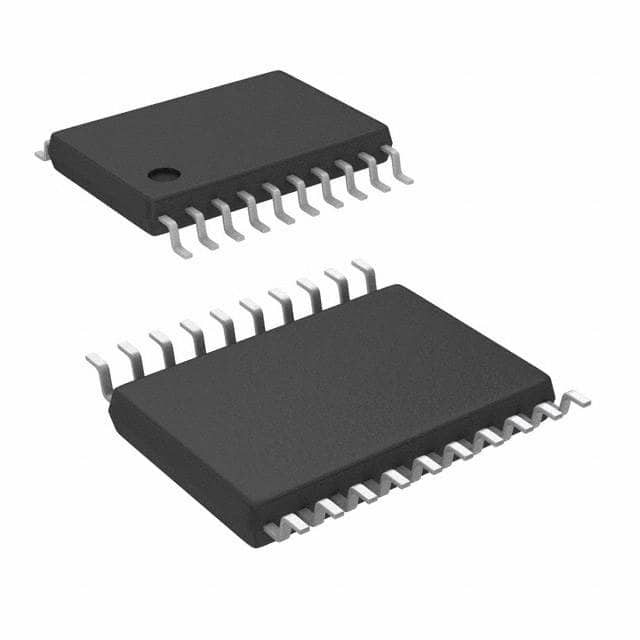Xem thông số kỹ thuật để biết chi tiết sản phẩm.

74LCX541TTR
Product Overview
Category
The 74LCX541TTR belongs to the category of integrated circuits (ICs).
Use
This IC is commonly used as a buffer/line driver for various digital applications.
Characteristics
- Low-voltage operation: The 74LCX541TTR operates at a low voltage, typically between 2.0V and 3.6V.
- High-speed performance: It offers fast switching times, making it suitable for high-frequency applications.
- Output current drive capability: The IC can provide sufficient current to drive external loads.
- Wide operating temperature range: It can operate reliably in temperatures ranging from -40°C to +85°C.
Package
The 74LCX541TTR is available in a TSSOP (Thin Shrink Small Outline Package) package.
Essence
The essence of the 74LCX541TTR lies in its ability to buffer and amplify digital signals, ensuring reliable transmission between different components of a digital system.
Packaging/Quantity
The IC is typically packaged in reels or tubes, with a quantity of 2500 units per reel/tube.
Specifications
- Supply Voltage Range: 2.0V to 3.6V
- Input Voltage Range: 0V to VCC
- Output Voltage Range: 0V to VCC
- Maximum Operating Frequency: 100MHz
- Input Capacitance: 4pF
- Output Current: ±24mA
Detailed Pin Configuration
The 74LCX541TTR has a total of 20 pins, which are assigned specific functions:
- OE (Output Enable)
- A1 (Input A1)
- Y1 (Output Y1)
- A2 (Input A2)
- Y2 (Output Y2)
- GND (Ground)
- Y3 (Output Y3)
- A3 (Input A3)
- Y4 (Output Y4)
- A4 (Input A4)
- VCC (Power Supply)
- Y5 (Output Y5)
- A5 (Input A5)
- Y6 (Output Y6)
- A6 (Input A6)
- Y7 (Output Y7)
- A7 (Input A7)
- Y8 (Output Y8)
- OE (Output Enable)
- GND (Ground)
Functional Features
- Bidirectional operation: The 74LCX541TTR allows data to be transmitted in both directions, making it suitable for bidirectional communication systems.
- Output enable control: The OE pin enables or disables the outputs, providing flexibility in controlling the signal flow.
- High-speed operation: With a maximum operating frequency of 100MHz, this IC ensures fast and efficient data transmission.
Advantages and Disadvantages
Advantages
- Low-voltage operation reduces power consumption.
- High-speed performance enables quick data transfer.
- Wide operating temperature range ensures reliability in various environments.
- Output current drive capability allows for driving external loads effectively.
Disadvantages
- Limited number of input/output channels compared to some other ICs.
- May require additional components for certain applications.
Working Principles
The 74LCX541TTR operates based on the principles of digital logic. It receives input signals, buffers them, and amplifies them to ensure proper transmission to the output pins. The output enable control allows for flexible signal routing, enabling bidirectional communication when required.
Detailed Application Field Plans
The 74LCX541TTR finds applications in various digital systems, including but not limited to: - Microcontrollers - Data communication systems - Memory modules - Industrial automation systems - Consumer electronics
Detailed and Complete Alternative Models
Some alternative models that can be considered as alternatives to the 74LCX541TTR are: - SN74LVC541A - MC74LCX541 - CD54HC541
These alternative models offer similar functionality and characteristics, providing options for different design requirements.
In conclusion, the 74LCX541TTR is a versatile integrated circuit used for buffering and amplifying digital signals. Its low-voltage operation, high-speed performance, and wide operating temperature range make it suitable for various applications in the digital domain.
Liệt kê 10 câu hỏi và câu trả lời thường gặp liên quan đến ứng dụng 74LCX541TTR trong giải pháp kỹ thuật
Sure! Here are 10 common questions and answers related to the application of 74LCX541TTR in technical solutions:
Q: What is the 74LCX541TTR? A: The 74LCX541TTR is a high-performance octal buffer/line driver with 3-state outputs, commonly used in digital logic circuits.
Q: What is the maximum operating voltage for the 74LCX541TTR? A: The maximum operating voltage for the 74LCX541TTR is typically 3.6V.
Q: How many inputs and outputs does the 74LCX541TTR have? A: The 74LCX541TTR has 8 inputs and 8 outputs.
Q: Can the 74LCX541TTR handle bidirectional data flow? A: No, the 74LCX541TTR is a unidirectional buffer, meaning it can only drive data from its inputs to its outputs.
Q: What is the purpose of the 3-state outputs on the 74LCX541TTR? A: The 3-state outputs allow the device to be effectively disconnected from the bus, enabling multiple devices to share the same bus without interfering with each other.
Q: What is the typical propagation delay of the 74LCX541TTR? A: The typical propagation delay of the 74LCX541TTR is around 3.5 ns.
Q: Can the 74LCX541TTR operate at high frequencies? A: Yes, the 74LCX541TTR is designed for high-speed operation and can handle frequencies up to several hundred megahertz.
Q: Is the 74LCX541TTR compatible with both TTL and CMOS logic levels? A: Yes, the 74LCX541TTR is designed to be compatible with both TTL and CMOS logic levels.
Q: Can the 74LCX541TTR drive capacitive loads? A: Yes, the 74LCX541TTR can drive capacitive loads up to a certain limit specified in the datasheet.
Q: What are some common applications for the 74LCX541TTR? A: The 74LCX541TTR is commonly used in bus interfacing, memory address decoding, and general-purpose digital logic circuits where buffering or line driving is required.
Please note that the answers provided here are general and may vary depending on the specific requirements and datasheet of the 74LCX541TTR.

